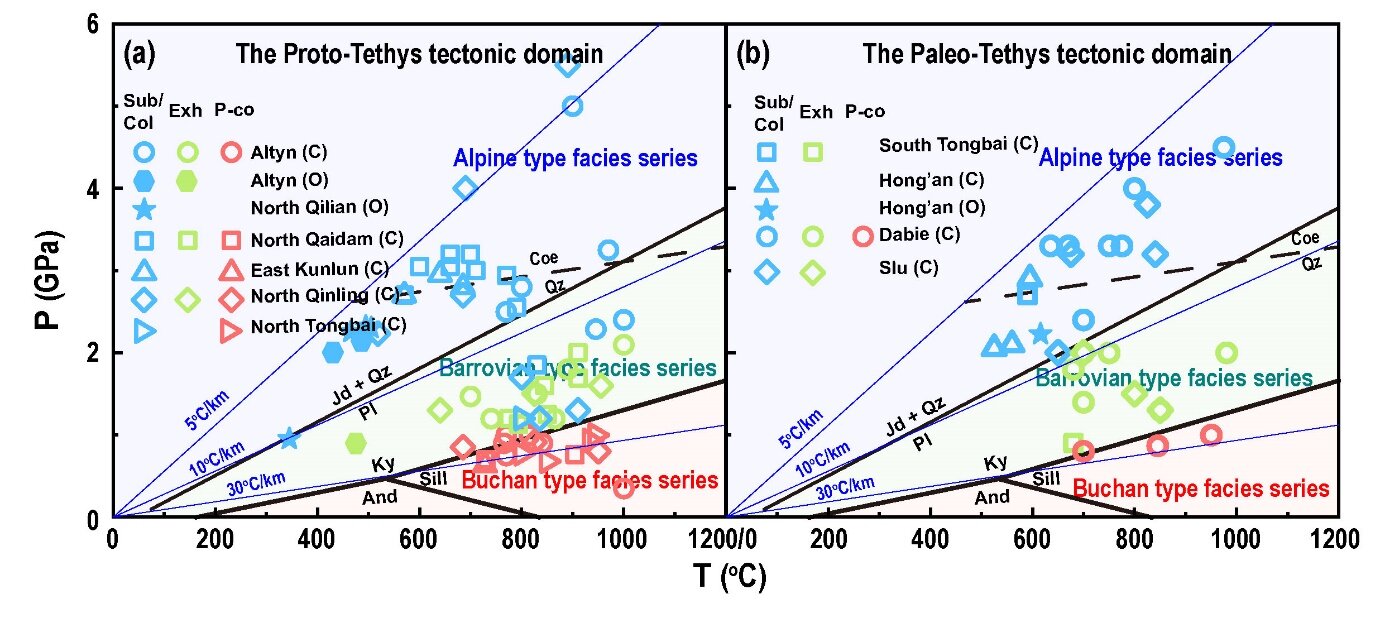

A synthesis study published in Science China Earth Sciences is led by Prof. Yong-Fei Zheng at University of Science and Technology of China. It focuses on the thermal and tectonic evolution of regional metamorphism at convergent continental margins based on a systematic outline of metamorphic temperature (T), pressure (P), and time (t) information on high-grade metamorphic rocks along the Central China Orogenic System (CCOS).
The CCOS includes the Proto-Tethys tectonic domain in western China and the Paleo-Tethys tectonic domain in eastern China, which were produced by the closure of the Proto-Tethys and Paleo-Tethys oceans, respectively.
As metamorphic rocks along the CCOS were produced at different stages, from continental subduction to post-collisional extension, they are robust recorders of metamorphic thermobaric information at the convergent continental margins and bear great significance in reconstructing their thermal and tectonic evolution.
Metamorphic T/P ratios and corresponding geothermal gradients for high-grade metamorphic rocks from both Proto-Tethys and Paleo-Tethys tectonic domains show an increasing trend with age.
It appears that these high-grade metamorphic rocks experienced three types of regional metamorphism in terms of their metamorphic T/P ratios: (1) an early stage of low T/P Alpine-type blueschist- to eclogite-facies high-P to ultrahigh-P metamorphism; (2) a middle stage of medium T/P Barrovian-type medium-P amphibolite to high-P granulite-facies metamorphism; and (3) a late stage of the high T/P Buchan-type low P amphibolite to MP granulite-facies metamorphism.
The ages of Alpine-type, Barrovian-type, and Buchan-type metamorphisms occurred at 500 to 400 Ma in the Paleozoic for the Proto-Tethys tectonic domain and 250 to 120 Ma in the Mesozoic for the Paleo-Tethys tectonic domain.
Convergent continental margins are characterized by the change of geothermal gradients during their tectonic evolution from dynamic compression to extension, giving rise to metamorphic rocks with different T/P ratios. In the stage of oceanic subduction, low geothermal gradients make cold subduction produce low T/P Alpine-type metamorphic rocks.
In the continental subduction/collision stage, the deep subduction of continental crust took place at low geothermal gradients, but its collisional thickening occurred at moderate geothermal gradients. Therefore, this stage would produce both low T/P Alpine-type and moderate T/P Barrovian-type metamorphic rocks.
In the post-collisional stage, the thickened continental lithosphere was thinned due to its gravitational or rheological instability, inducing asthenospheric upwelling and leading the thinned lithosphere to high geothermal gradients for high T/P Buchan-type metamorphism.
Based on the P-T information on and spatiotemporal relationships between the metamorphic rocks in the different orogens along the CCOS, the tectonic evolution of the Proto-Tethys and Paleo-Tethys tectonic domains can be reconstructed as follows.
The continental collision/subduction in the Proto-Tethys orogenic system would occur either at 500–490 Ma in the Altyn, North Qinling and North Tongbai orogens or at 450–430 Ma in the North Qaidam and East Kunlun orogens and continental rifting would occur either at 460–450 Ma in the Altyn, North Qinling and North Tongbai orogens or at 410–400 Ma in the North Qaidam and East Kunlun orogens.
On the other hand, continental subduction/collision in the Paleo-Tethys orogenic system would occur at 250–220 Ma, and continental rifting would occur at 140–120 Ma.
Although timescales of either continental deep subduction or hard collision are restricted to 10–30 Myr, time intervals between the low T/P Alpine-type metamorphism and the high T/P Buchan-type metamorphism are as short as about 40–60 Myr for the Proto-Tethys tectonic domain but as long as about 110 Myr for the Paleo-Tethys tectonic domain.
These similarities and differences indicate that the high-grade metamorphic rocks in the two different Tethys tectonic domains record the tectonic transition of convergent continental margins from cold subduction through warm collision or exhumation to hot rifting. This is associated with the metamorphic transformation from the early Alpine-type facies series to the late Barrovian-type facies series and then superimposition by the Buchan-type facies series.
More information:
Qiangqiang Zhang et al, Metamorphic evolution of the East Tethys tectonic domain and its tectonic implications, Science China Earth Sciences (2023). DOI: 10.1007/s11430-023-1209-6
Provided by
Science China Press
Citation:
Metamorphic evolution of the East Tethys tectonic domain and its tectonic implications (2023, December 8)
retrieved 9 December 2023
from https://phys.org/news/2023-12-metamorphic-evolution-east-tethys-tectonic.html
This document is subject to copyright. Apart from any fair dealing for the purpose of private study or research, no
part may be reproduced without the written permission. The content is provided for information purposes only.





